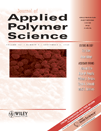Ammonia-gas and liquid ammonia treatments of silk fabric
Abstract
Silk fabric, Habutae, was treated with 100% ammonia-gas under atmospheric pressure and at pressures of 2, 4, and 6 kgf/cm2, and with liquid ammonia at −33°C. The effects of the treatment were investigated on the basis of the X-ray diffraction, DSC thermogram, moisture regain, water absorption, dyeing property, and mechanical property of the fabric. Crystallinity and equilibrium dye uptake were increased apparently by the liquid ammonia treatment, whereas effect of the ammonia-gas treatment was less than the liquid ammonia treatment. KES (Kawabata Evaluation System) shearing, bending, and tensile parameters were obtained. The modulus G, B, and hysteresis widths 2HG, 2HG5, and 2HB were decreased with the ammonia-gas treatment. On the contrary, the liquid ammonia treatment increased the parameters considerably. Therefore, it seemed that the ammonia-gas treatment is effective in enhancing the soft hand of the silk fabric. © 2006 Wiley Periodicals, Inc. J Appl Polym Sci 101: 3487–3492, 2006




